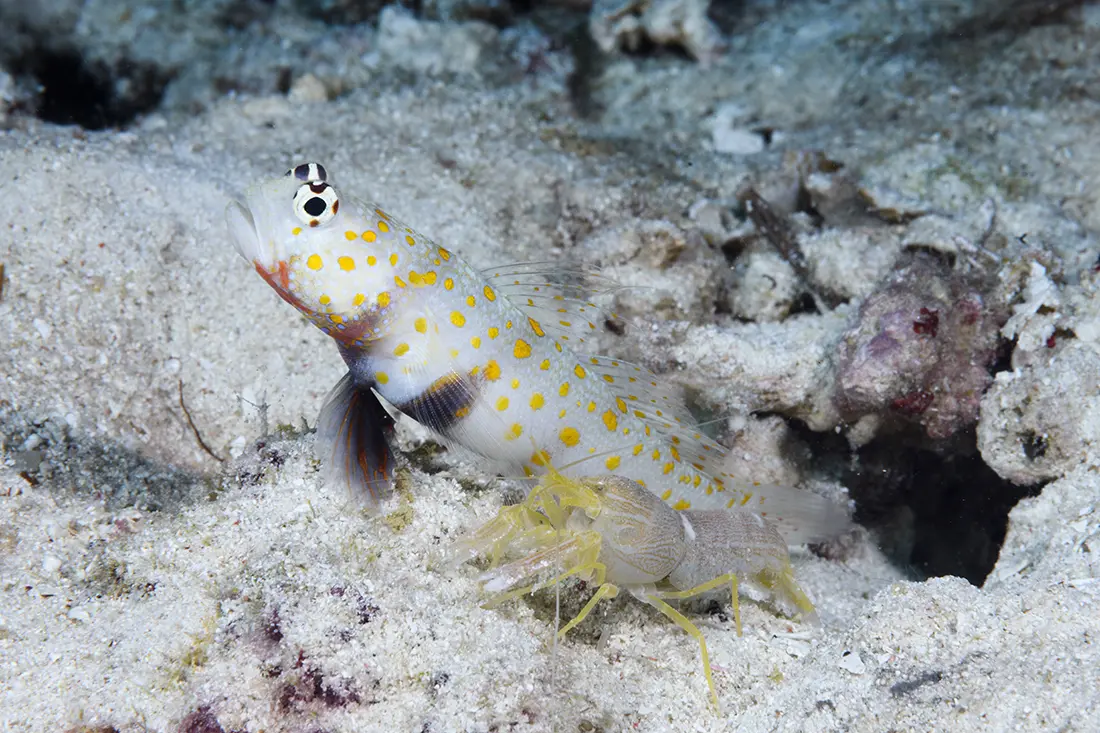A closer look at one of the ocean's most interesting partnerships; fish and crustaceans at Wakatobi.
With thousands of species of fish and invertebrates to discover on the reefs surrounding Wakatobi Dive Resort, divers may find themselves slipping into “checklist mode” as they scan for that next elusive find to photograph or add to the tally. But sometimes, identification and documentation aren't enough. There are animals and behaviors that deserve a closer—and longer—look. This is certainly the case when you come across one of the most entertaining pairings in the ocean, and you can find these odd couples at many sites around the resort.
A mutually beneficial arrangement
Locate a patch of sand, mud or rubble bottom at one of Wakatobi's dive sites and there's a good chance you will run across a small fish perched above or in front a small hole in the seabed. What you have found is a variety of goby roughly 2-inches long. Take a second or two to look closer you may find that it is not alone. I may have a mate of equal size it is sharing its burrow with. But it doesn’t end there. Watching the hole closely, you might also note a pair of slender antenna poking out of the hole, making contact with the little fish's flank or tail. You have just discovered a shrimp goby and its near-constant crustacean companion, the Alpheus shrimp.
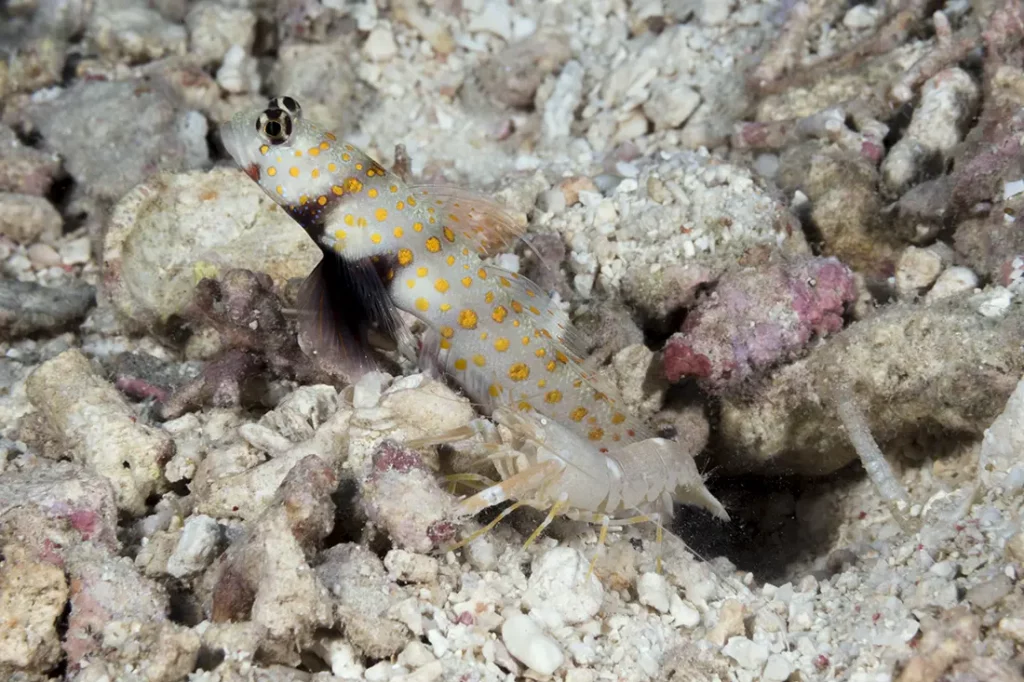
Most divers are familiar with the symbiotic relationships formed by anemones and clownfish, in which the fish provides housekeeping services in exchange for protection. A similar and in many ways more entertaining partnership takes place between a variety of snapping shrimp of the genus Alpheus and a bottom-dwelling species of gobies belong to the genus Amblyeleotris, Cryptocentrus, or Stonogobiops. Yes folks we are talking about more than one variety.
It's a partnership that's common across a large part of both the tropical Pacific and Indian Ocean, involving more than 70 species of gobies and dozens of species of shrimp. When comes to diving the waters of the Indo-Pacific, not only is it a contest in just how many species can be found, but the daily behaviors of these little creatures also makes for some fabulous fish watching.
How this relationship between fish and crustacean is still undetermined. The short version in how it works is that Alpheus shrimp is nearly blind shrimp relying on the goby as a lookout while it works on its burrow. The goby, in return for its services, gets free shelter in the same underground borrow built and maintained by the shrimp.
Division of labor
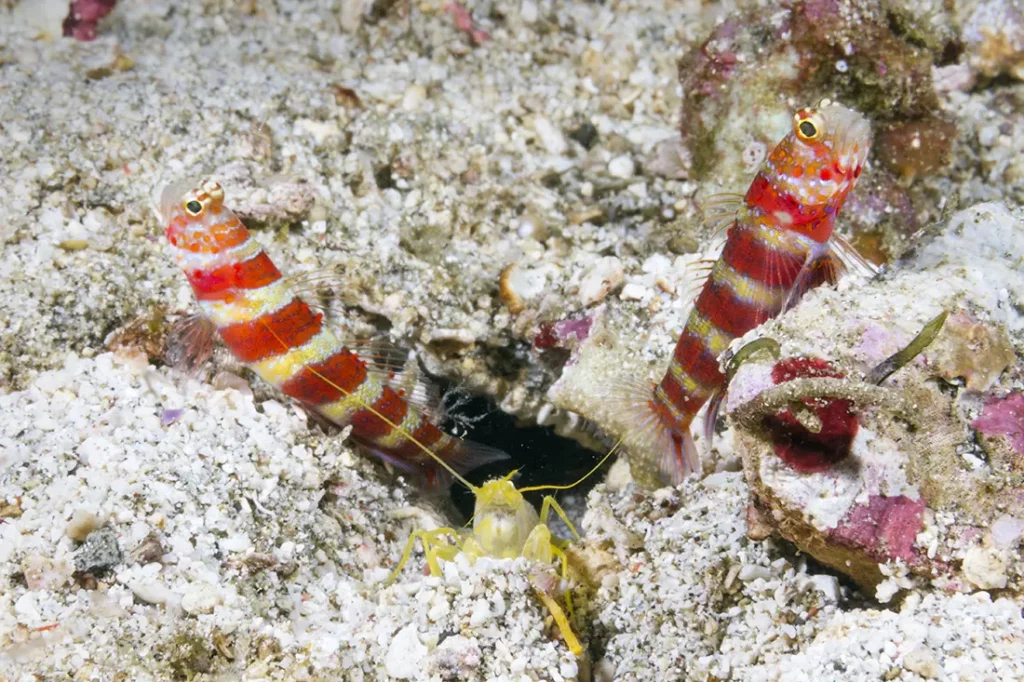
The daily goings on of a shrimp and goby pair are in many ways reminiscent of the classic television series The Odd Couple, in which the fastidious Felix Unger shares an apartment with the slovenly Oscar Madison. In much the same way, Alpheus shrimp devote their waking hours to almost constant house cleaning, while the goby doesn't lift a fin to help. This effort isn't obsessive, however, because without this constant cleaning, the hole in the ground they occupy would collapse on itself within a matter of hours. But though the goby isn't involved in the never-ending task of borrow reconstruction and maintenance, its presence is vital to the shrimp's safety. These keen-eyed little fish remain on high alert for predators, and at the first sign of a threat, will use a flick of the tail to alert its burrow-building companion to go and stay below. If the threat becomes more imminent, the goby will perform a lightening quick U-turn, ducking headfirst into the hole for safety.
Once the goby perceives it to be all-clear it will start to reemerge using its pectoral fins to prop on the edge of the borrow to better scan their surroundings. The shrimp's return is often more tentative, and patient watchers may see the tip of an antenna work its way slowly up the goby's body as the shrimp eases its way out of the hole. At times, the goby may lead the shrimp short distances from the burrow’s entrance, looking for all the world like a seeing eye dog leading its charge on a walk. When this takes place, both goby and shrimp are likely feeding. Gobies will gulp mouthfuls of sand that are filtered through its gills to extract tiny morsels. Meanwhile, the shrimp roots through the sea floor, using its enlarged front claws to uncover detritus, tiny crustaceans and worms. Some shrimp will also cultivate an algae garden close to the borrow mouth. Such feeding forays are generally conducted in the morning hours, while afternoons are devoted to burrow maintenance.
Building a better borrow
Alpheus shrimp are incessant diggers where they use their enlarged front claws as a form of front loader to push, grab and lift granules of sand, shell and coral fragments even pebbles into place. In some instances, they are often used like augers to jab into a patch of sand or mud, then twisting to loosen the sediment. The shrimp's middle legs, more properly known as chelae and pereipods, do most of the actual digging and movement of sand and other debris. Though they may look like little more than a hole in the seabed from outside, burrows can be quite spacious, sometimes housing more than one shrimp goby pair. Observers have counted as many as a half dozen groups sharing an underground shelter.
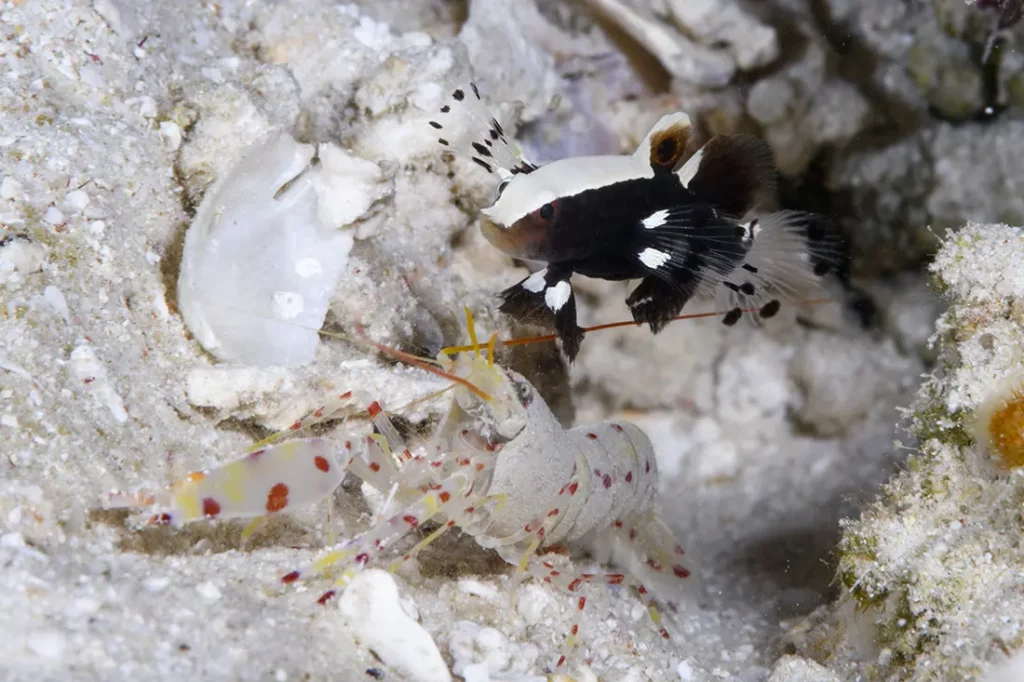
The burrows themselves are walled and roofed with fragments of shell, coral and rock that create a permanent structure, while floors are made of softer sand and mud. The tunnels leading to the borrow interior are often constructed a bit more haphazardly, and their outer openings usually collapse inward at night, providing shrimp and goby inhabitants with the equivalent of a locked front door. Next morning, the shrimp will dig its way out to daylight, but may create a new exit in the process. As a result, individual openings may shift about over time, but these new holes will likely lead to the same burrow.
Social Networking
Just as humans sometimes do, shrimp/goby pairs tend to create neighborhoods lacking in diversity. If there are several burrows in a given area of seabed, they are likely populated by the same species of goby and shrimp. Of course, this makes sense given the self-imposed restrictions on movement the pairings create. A gentleman goby would have a hard time maintaining a long-distance romance given the constant requirements of his multi-legged roommate. Partnerships are formed soon after shrimp and goby grow beyond the larval stage. It's not clear who finds whom, but researchers have determined that the goby will identify a likely shrimp by sight, while the shrimp uses its olfactory senses to sniff out a buddy. Once paired up, shrimps and gobies maintain stable relationships, but they will change partners from time to time, and there are also cases where one goby will team up with two shrimp.
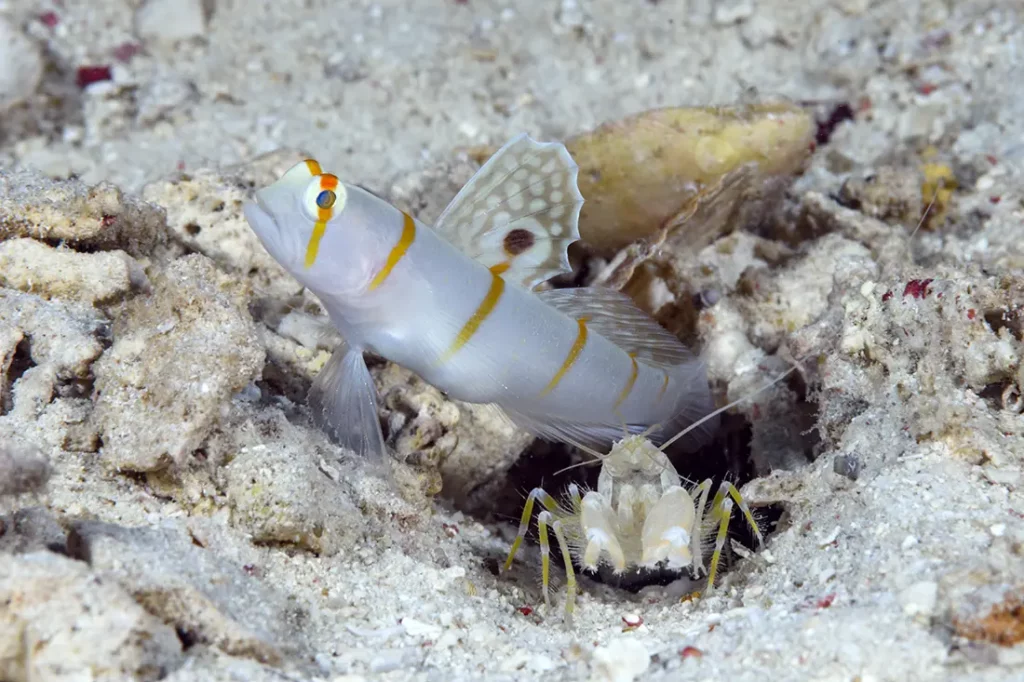
Because both shrimp and goby spend a good bit of their time underground, marine biologists have encountered some difficulties in the study of these two species reproductive habitats. It is known that goby males will venture forth for at least a snort distance from their holes in search of a potential mate and will compete with other males; the big guys with the most attitude usually get the girls. Once paired, a male mate with only one female at a time. They head back to his place, where she lays up to 20,000 eggs. The courtship may last for several days before she moves out. The progeny are then left in the care of the male, and will hatch within a week. Meanwhile, like other shrimp, the Alpheus leave the child rearing to the females, who will carry a brood of as many as 4000 fertilized eggs. Once these tiny creatures hatch, they will immediately burrow into the protective sea floor, reemerging once large enough to fend for themselves—and begin the search for a goby of their own. Both shrimp and goby will reach sexual maturity within a year, and mortality studies suggest that even those that survive to adulthood usually have a life expectancy of around two years.
Without a doubt, there's a lot more going on around those little holes in the bottom of the sea than a casual observer might think. And this is just one of many such fascinating stories that await those who take the time for a closer look at the underwater wonders that surround Wakatobi Resort. We hope you will have a chance to meet some of these fascinating creatures for yourself in the hear future.

To learn more visit Wakatobi.com or contact the team at office@wakatobi.com
